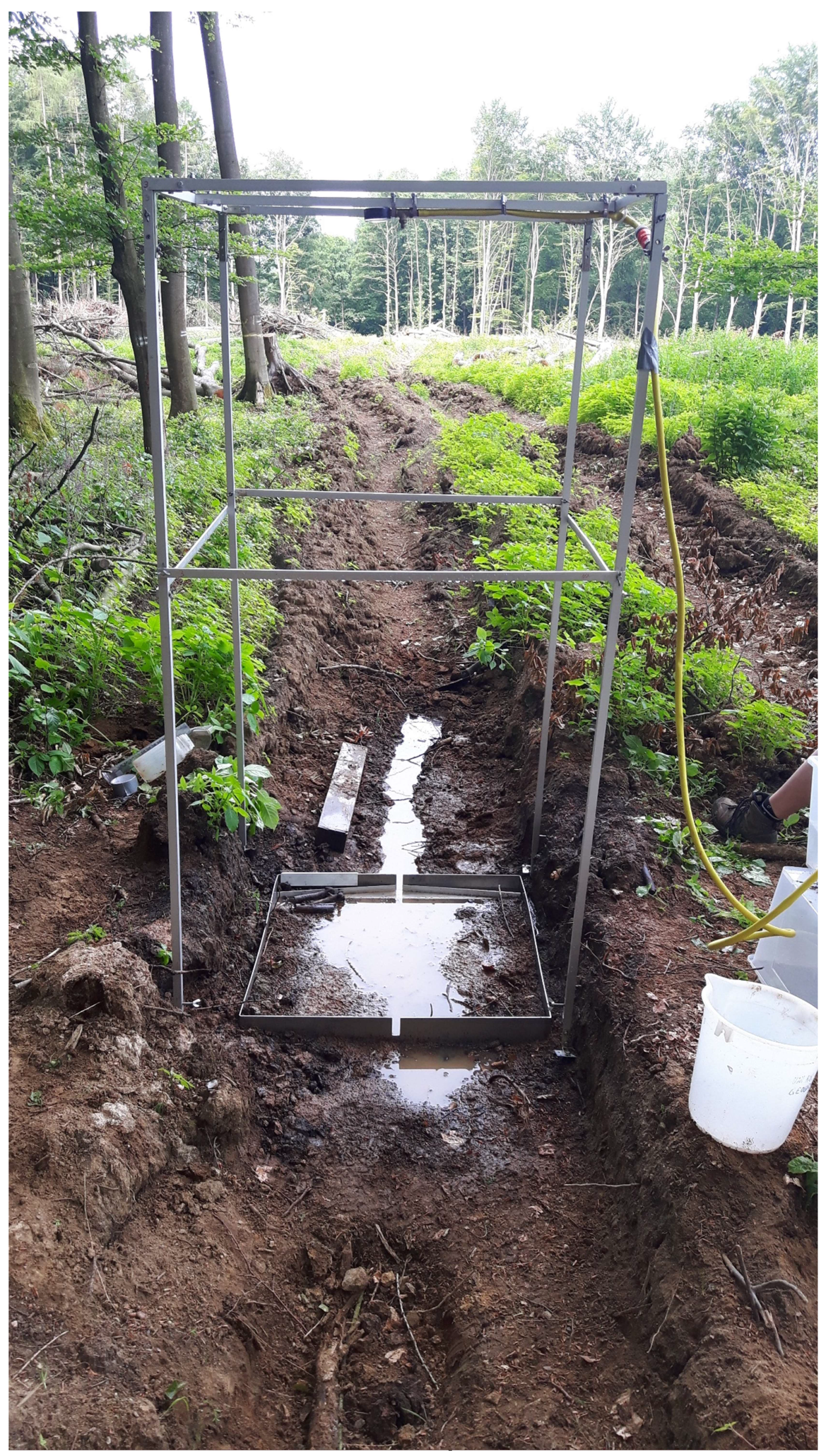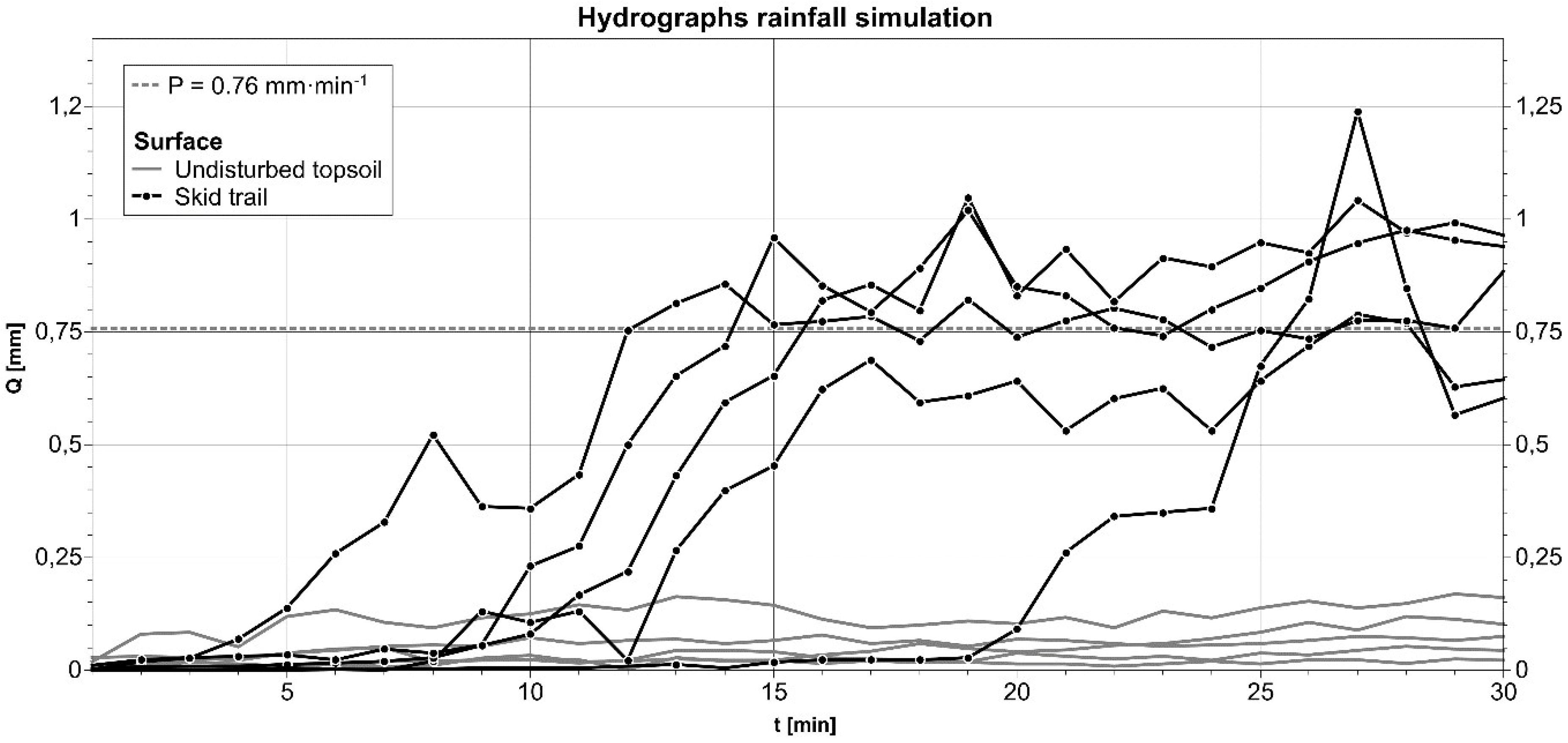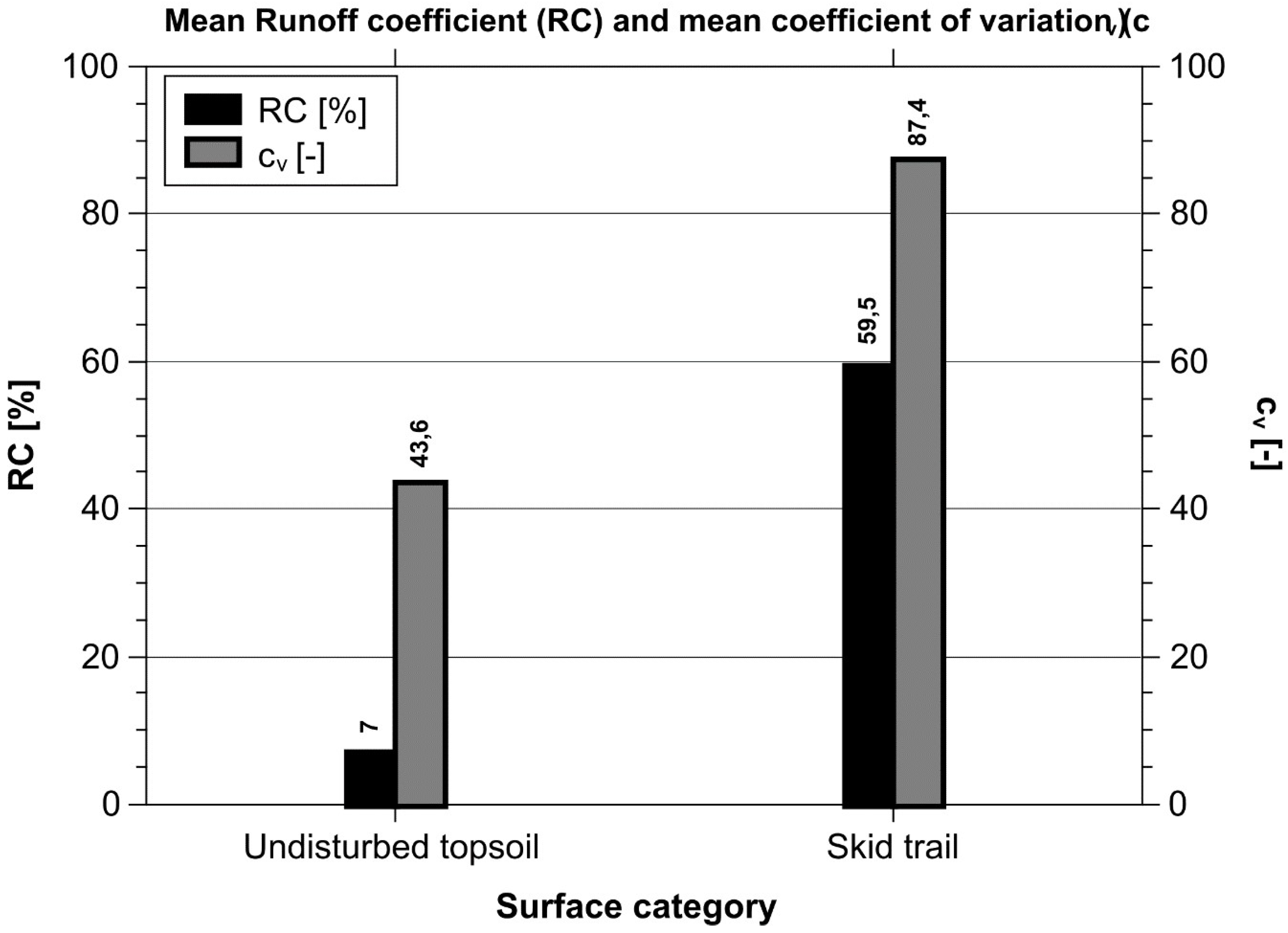The Influence of Soil Compaction on Runoff Formation. A Case Study Focusing on Skid Trails at Forested Andosol Sites
Abstract
1. Introduction
2. Materials and Methods
2.1. Study Area
2.2. Soil Physical Properties
2.3. Soil Hydrological Properties
3. Results
3.1. Soil Physical Properties
3.1.1. Undisturbed Soil Physical Properties
3.1.2. Soil Compaction
3.2. Soil Hydrological Properties
3.2.1. Infiltration
3.2.2. Rainfall Simulation
4. Discussion
5. Conclusions
Author Contributions
Funding
Conflicts of Interest
References
- Baales, M.; Jöris, O.; Street, M.; Bittmann, F.; Weninger, B.; Wiethold, J. Impact of the Late Glacial Eruption of the Laacher See Volcano, Central Rhineland, Germany. Quat. Res. 2002, 58, 273–288. [Google Scholar] [CrossRef]
- Schmincke, H.-U.; Park, C.; Harms, E. Evolution and environmental impacts of the eruption of Laacher See Volcano (Germany) 12,900 a BP. Quat. Int. 1999, 61, 61–72. [Google Scholar] [CrossRef]
- Riede, F.; Bazely, O.; Newton, A.J.; Lane, C.S. A Laacher See-eruption supplement to Tephrabase: Investigating distal tephra fallout dynamics. Quat. Int. 2011, 246, 134–144. [Google Scholar] [CrossRef]
- Kleber, M.; Jahn, R. Andosols and soils with andic properties in the German soil taxonomy. J. Plant Nutr. Soil Sci. 2007, 170, 317–328. [Google Scholar] [CrossRef]
- Rennert, T.; Eusterhues, K.; Hiradate, S.; Breitzke, H.; Buntkowsky, G.; Totsche, K.U.; Mansfeldt, T. Characterisation of Andosols from Laacher See tephra by wet-chemical and spectroscopic techniques (FTIR, 27Al-, 29Si-NMR). Chem. Geol. 2014, 363, 13–21. [Google Scholar] [CrossRef]
- Kleber, M.; Mikutta, C.; Jahn, R. Andosols in Germany—Pedogenesis and properties. Catena 2004, 56, 67–83. [Google Scholar] [CrossRef]
- Hahn, J.; Opp, C. Eigenschaften von Laacher See-Tephra enthaltenden Bodensubstraten in eruptionsnaher und eruptionsferner Position. In Proceedings of the Jahrestagung der DBG 2011, Berlin, Germany, 3–9 September 2011. [Google Scholar]
- Jimènez, C.C.; Tejedor, M.; Morillas, G.; Neris, J. Infiltration rate of andisols: Effect of changes in vegetation cover (Tenerife, Spain). J. Soil Water Conserv. 2006, 61, 153–158. [Google Scholar]
- Neris, J.; Jimènez, C.; Fuentes, J.; Morillas, G.; Tejedor, M. Vegetation and land-use effects on soil properties and water infiltration of Andisols in Tenerife (Canary Islands, Spain). Catena 2012, 98, 55–62. [Google Scholar] [CrossRef]
- Tejedor, M.; Neris, J.; Jimènez, C. Soil properties controlling infiltration in volcanic soils (Tenerife, Spain). Soil Sci. Soc. Am. J. 2012, 77, 202–212. [Google Scholar] [CrossRef]
- Neris, J.; Tejedor, M.; Rodríguez, M.; Fuentes, J.; Jiménez, C. Effect of forest floor characteristics on water repellency, infiltration, runoff and soil loss in Andisols of Tenerife (Canary Islands, Spain). Catena 2013, 108, 50–57. [Google Scholar] [CrossRef]
- Nanzyo, M.; Shoji, S.; Dahlgren, R. Physical characteristics of volcanic ash soils. In Volcanic Ash Soils: Genesis, Properies and Utilization; Shoji, S., Nazyo, M., Dahlgren, R., Eds.; Elsevier Science Publishers B.V.: Amsterdam, The Netherlands, 1993; p. 288. [Google Scholar]
- Orradottir, B.; Archer, S.R.; Arnalds, O.; Wilding, L.P.; Thurow, T.L. Infiltration in Icelandic Andisols: The role of vegetation and soil frost. Arct. Antarct. Alp. Res. 2008, 40, 412–421. [Google Scholar] [CrossRef]
- Zemke, J.J. Runoff and Soil Erosion Assessment on Forest Roads Using a Small Scale Rainfall Simulator. Hydrology 2016, 3, 25. [Google Scholar] [CrossRef]
- Foltz, R.B.; Copeland, N.S.; Elliot, W.J. Reopening abandoned forest roads in northern Idaho, USA: Quantification of runoff, sediment concentration and infiltration, and interrill erosion parameters. J. Environ. Manag. 2009, 90, 2542–2550. [Google Scholar] [CrossRef]
- La Marche, J.L.; Lettenmaier, D.P. Effetcs of forest roads on flood flows in the Deschutes River, Washington. Earth Surf. Process. Landf. 2001, 26, 115–134. [Google Scholar] [CrossRef]
- Horn, R.; Vossbrink, J.; Becker, S. Modern forestry vehicles and their impacts on soil physical properties. Soil Tillage Res. 2004, 79, 207–219. [Google Scholar] [CrossRef]
- Luce, C.H. Hydrological processes and pathways affected by forest roads: What do we still have to learn? Hydrol. Process. 2002, 16, 2901–2904. [Google Scholar] [CrossRef]
- Wemple, B.C.; Clark, E.C.; Ross, D.S.; Rizzo, D.M. Identifying the spatial pattern and importance of hydro-geomorphic drainage impairments on unpaved roads in the northeastern USA. Earth Surf. Process. Landf. 2017, 42, 1652–1665. [Google Scholar] [CrossRef]
- Jones, J.A.; Achterman, G.L.; Augustine, L.A.; Creed, I.F.; Ffolliott, P.F.; MacDonald, L.; Wemple, B.C. Hydrologic effects of a changing forested landscape—Challenges for the hydrological sciences. Hydrol. Process. 2009, 23, 2699–2704. [Google Scholar] [CrossRef]
- Selby, M.J.; Hosking, P.J. Causes of infiltration into yellow-brown pumice soils. J. Hydrol. (N. Z.) 1971, 10, 113–119. [Google Scholar]
- Page-Dumroese, D.; Miller, R.; Mital, J.; McDaniel, P.; Miller, D. Volcanic-Ash-Derived Forest Soils of the Inland Northwest: Properties and Implications for Management and Restoration; Proceedings RMRS-P-44; U.S. Department of Agriculture, Forest Service, Rocky Mountain Research Station: Fort Collins, CO, USA, 2007.
- Food and Agriculture Organization of the United Nations (FAO). World Reference Base for Soil Resources 2014. International Soil Classification System for Naming Soils and Creating Legends for Soil Maps. Update 2015; FAO: Rome, Italy, 2015; pp. 146–147. [Google Scholar]
- Shukla, M.K. Soil Physics: An Introduction; CRC Press: Boca Raton, FL, USA, 2014. [Google Scholar]
- Blake, G.R.; Hartge, K.H. Particle density. In Methods of Soil Analysis. Part 1; Klute, A., Ed.; ACSESS DL: Madison, WI, USA, 1986; pp. 377–382. [Google Scholar]
- Bouwer, H. Intake rate: Cylinder infiltrometer. In Methods of Soil Analysis. Part 1; Klute, A., Ed.; ACSESS DL: Madison, WI, USA, 1986; pp. 825–844. [Google Scholar]
- Johnson, A.I. A Field Method for Measurement of Infiltration; Geological Survey Water Supply Paper 1544-F; U.S. Government Printing Office: Washington, DC, USA, 1963.
- Eijkelkamp Company. Double Ring Infiltrometer Operating Instructions; Eijkelkamp: Giesbeek, NL, USA, 2012; Available online: https://www.eijkelkamp.com/files/media/Gebruiksaanwijzingen/EN/m1-0904eringinfiltrometer.pdf (accessed on 15 April 2019).
- Bear, J. Dynamics of Fluids in Porous Media; American Elsevier Publishing Company Inc.: New York, NY, USA, 1972. [Google Scholar]
- Zemke, J.J. Set-up and calibration of a portable small scale rainfall simulator for assessing soil erosion processes at interrill scale. Cuad. De Investig. Geográfica 2017, 43, 63–81. [Google Scholar] [CrossRef]
- Iserloh, T.; Ries, J.B.; Arnáez, J.; Boix Fayos, C.; Butzen, V.; Cerdà, A.; Echeverría, M.T.; Fernández-Gálvez, J.; Fister, W.; Geißler, C.; et al. European small portable rainfall simulators: A comparison of rainfall characteristics. Catena 2013, 110, 100–112. [Google Scholar] [CrossRef]
- Hillel, D. Introduction to Soil Physics; Academic Press Inc.: New York, NY, USA, 1982. [Google Scholar]
- Hillel, D. Introduction to Environmental Soil Physics; Elsevier Science: San Diego, CA, USA, 2004. [Google Scholar]
- Arshad, M.A.; Lowery, B.; Grossmann, B. Physical tests for monitoring soil quality. In Methods for Assessing Soil Quality. Soil Science Society of America Special Publication 49; Doran, J.W., Jones, A.J., Eds.; Soil Science Society of America: Madison, WI, USA, 1996; pp. 123–142. [Google Scholar]
- United States Department of Agriculture (USDA). Soil Quality Test Kit Guide; USDA Agricultural Research Service, Natural Resources Conservation Service, Soil Quality Institute: Washington, DC, USA, 1999.
- Landesamt für Geologie und Bergbau Rheinland-Pfalz (LGB RLP). Steckbriefe: Charakteristik rheinland-pfälzischer Steine und Erden; MWVLW RLP: Mainz, Germany, 2015; Available online: https://www.lgb-rlp.de/fileadmin/service/lgb_downloads/rohstoffe/rohstoffe_allgemein/steckbriefe_-_charakteristik_rheinland-pfaelzischer_steine_und_erden_01.pdf (accessed on 8 March 2019).
- Ampoorter, E.; Van Nevel, L.; De Vos, B.; Hermy, M.; Verheyen, K. Assessing the effects of initial soil characteristics, machine mass and traffic intensity on forest soil compaction. For. Ecol. Manag. 2010, 260, 1664–1676. [Google Scholar] [CrossRef]
- Lenhard, R.J. Changes in Void Distribution and Volume During Compaction of a Forest Soil. Soil Sci. Soc. Am. J. 1986, 50, 462–464. [Google Scholar] [CrossRef]
- Hillel, D. Environmental Soil Physics; Academic Press: San Diego, CA, USA, 1998. [Google Scholar]
- Fisher, R.F.; Binkley, D. Ecology and Management of Forest Soils; Wiley: New York, NY, USA, 2000. [Google Scholar]
- Brais, S.; Camiré, C. Soil compaction induced by careful logging in the claybelt region of northwestern Quebec (Canada). Can. J. Soil Sci. 1998, 78, 197–206. [Google Scholar] [CrossRef]
- Ampoorter, E.; Goris, R.; Cornelis, W.M.; Verheyen, K. Impact of mechanized logging on compaction status of sandy forest soils. For. Ecol. Manag. 2007, 241, 162–174. [Google Scholar] [CrossRef]
- Cambi, M.; Certini, G.; Neri, F.; Marchi, E. The impact of heavy traffic on forest soils: A review. For. Ecol. Manag. 2015, 338, 124–138. [Google Scholar] [CrossRef]
- Ampoorter, E.; Schrijver, A.; Nevel, L.; Hermy, M.; Verheyen, K. Impact of mechanized harvesting on compaction of sandy and clayey forest soils: Results of a meta-analysis. Ann. Sci. 2012, 69, 533–542. [Google Scholar] [CrossRef]
- Powers, R.F.; Scott, D.A.; Sanchez, F.G.; Voldseth, R.A.; Page-Dumroese, D.; Elioff, J.D.; Stone, D.M. The North American long-term soil productivity experiment: Findings from the first decade of research. Ecol. Manag. 2005, 220, 31–50. [Google Scholar] [CrossRef]
- Williamson, J.R.; Neilsen, W.A. The influence of forest site on rate and extent of soil compaction and profile disturbance of skid trails during ground-based harvesting. Can. J. Res. 2000, 30, 1196–1205. [Google Scholar] [CrossRef]
- Croke, J.; Mockler, S. Gully initiation and road-to-stream linkage in a forested catchment, Southeastern Australia. Earth Surf. Process. Landf. 2001, 26, 205–217. [Google Scholar] [CrossRef]
- McNabb, D.H.; Boersma, L. Evolution of the relationship between compressibility and shear strength of Andisols. Soil Sci. Soc. Am. J. 1993, 57, 923–929. [Google Scholar] [CrossRef]
- Cullen, S.J.; Montagne, C.; Ferguson, H. Timber harvest trafficking and soil compaction in western Montana. Soil Sci. Soc. Am. J. 1991, 55, 1416–1421. [Google Scholar] [CrossRef]
- Geist, J.M.; Hazrd, J.W.; Seidel, K.W. Assessing physical conditions of some Pacific Northwest volcanic ash soils after forest harvest. Soil Sci. Am. J. 1989, 53, 946–950. [Google Scholar] [CrossRef]
- Page-Domroese, D.S. Susceptibility of Volcanic Ash-Influenced Soils in Northern Idaho to Mechanical Compaction; Research Note Int-409; U.S. Department of Agriculture, Forest Service, Intermountain Research Station: Ogden, UT, USA, 1993.
- Parker, R.T.; Maguire, D.A.; Marshall, D.D.; Cochran, P. Ponderosa Pine growth response to soil strength in the volcanic ash soils of Central Oregon. West. J. Appl. 2007, 22, 134–141. [Google Scholar]
- Ares, A.; Terry, T.A.; Miller, R.E.; Anderson, H.W.; Flaming, B.L. Ground-Based Forest Harvesting Effetcs on Soil Physical Properties and Douglas-Fir Growth. Soil Sci. Soc. Am. J. 2005, 69, 1822–1832. [Google Scholar] [CrossRef]
- Kimble, J.M.; Ping, C.L.; Sumner, M.E.; Wilding, L.P. Classification of Soils: Andisols. In Handbook of Soil Science; Sumner, M.E., Ed.; CRC Press: New York, NY, USA, 2000. [Google Scholar]
- Croke, J.; Hairsine, P.; Fogarty, P. Soil recovery from track construction and harvesting changes in surface infiltration, erosion and delivery rates with time. Ecol. Manag. 2001, 143, 3–12. [Google Scholar] [CrossRef]
- Christopher, E.; Visser, R. Methodology for evaluating post-harvest erosion risk for the protection of water quality. N. Z. J. Sci. 2007, 52, 20–25. [Google Scholar]
- Bonell, M. Progress in the understanding of runoff generation dynamics in forests. J. Hydrol. 1993, 150, 217–275. [Google Scholar] [CrossRef]
- Grant, G.E.; Lewis, S.L.; Swanson, F.J.; Cissel, J.H.; McDonnell, J.J. Effects of Forest Practices on Peak Flows and Consequent Channel Response: A State-of-Science Report for Western Oregon and Washington; USDA Forest Service General Technical Report PNW-GTR-760; U.S. Department of Agriculture, Forest Service, Pacific Northwest Research Station: Portland, OR, USA, 2008.
- Brouwer, C.; Prins, K.; Kay, M.; Heibloem, M. Irrigation Water Management. Training Manual No 5. Irrigation Methods; Food and Agriculture Organization of the United Nations (FAO): Rome, Italy; Available online: http://www.fao.org/3/S8684E/s8684e00.htm#Contents (accessed on 8 March 2019).
- Startsev, A.D.; McNabb, D.H. Effects of skidding on forest soil infiltration in west-central Alberta. Can. J. Soil Sci. 2000, 80, 617–624. [Google Scholar] [CrossRef]
- MacDaniel, P.A.; Wilson, M.A. Physical and Chemical Characteristics of Ash-influenced Soils of Inland Northwest Forests. In Volcanic-Ash-Derived Forest Soils of the Inland Northwest: Properties and Implications for Management and Restoration; Page-Dumroese, D., Miller, R., Mital, J., McDaniel, P., Miller, D., Eds.; Proceedings RMRS-P-44; USDA Forest Service, Rocky Mountain Research Station: Fort Collins, CO, USA, 2007. [Google Scholar]








| Cross Section | α [°] | DBD 1 [g·cm−3] | Particle Density [g·cm−3] | Gravel [%] | Sand [%] | Texture 2 |
|---|---|---|---|---|---|---|
| 1 | 2.2 | 1.16 | 2.12 | 11 | 43 | CL |
| 2 | 2.9 | 1.10 | 2.02 | 10 | 34 | CL |
| 3 | 3.3 | 0.75 | 1.95 | 21 | 41 | L |
| 4 | 2.6 | 0.85 | 1.91 | 12 | 53 | SCL |
| 5 | 3.1 | 0.84 | 1.92 | 19 | 53 | SL |
| 6 | 2.3 | 0.85 | 1.94 | 15 | 46 | L |
| 7 | 2.8 | 0.83 | 1.98 | 14 | 51 | SL |
| 8 | 1.7 | 0.64 | 1.84 | 29 | 63 | SL |
| 9 | 1.8 | 0.66 | 1.87 | 25 | 58 | SL |
| 10 | 2.2 | 0.63 | 1.88 | 20 | 62 | SL |
| 11 | 2.1 | 0.87 | 1.85 | 10 | 39 | L |
| 12 | 6.2 | 0.77 | 2.01 | 10 | 65 | SL |
| 13 | 9.9 | 0.75 | 2.01 | 4 | 45 | SL |
| 14 | 13.0 | 0.82 | 2.08 | 7 | 55 | L |
| Ø | 4.0 | 0.82 | 1.95 | 15 | 50 | L |
| Class | −log10·K (cm·s−1) |
|---|---|
| Pervious | −2 to < 2 |
| Semipervious | 2 to < 6 |
| Impervious | 6 to < 11 |
| Cross Section | n | DBDundisturbed [g·cm−3] | DBDwheel rut [g·cm−3] |
|---|---|---|---|
| 1 | 10 | 1.16 | 1.39 (+20%) |
| 2 | 24 | 1.10 | 1.42 (+29%) |
| 3 | 10 | 0.75 | 1.25 (+67%) |
| 4 | 10 | 0.85 | 1.01 (+19%) |
| 5 | 24 | 0.84 | 0.96 (+14%) |
| 6 | 24 | 0.85 | 0.88 (+4%) |
| 7 | 10 | 0.83 | 0.88 (+6%) |
| 8 | 10 | 0.64 | 0.78 (+22%) |
| 9 | 11 | 0.66 | 0.79 (+20%) |
| 10 | 10 | 0.63 | 0.84 (+33%) |
| 11 | 10 | 0.87 | 1.05 (+21%) |
| 12 | 10 | 0.77 | 0.86 (+12%) |
| 13 | 25 | 0.75 | 0.88 (+17%) |
| 14 | 10 | 0.82 | 0.90 (+10%) |
| Surface Category | Mean initial Infiltration Rate [mm·h−1] | Mean Ksat [mm·h−1] | Permeability Class |
|---|---|---|---|
| Undisturbed topsoil | 2622.7 | 589.0 | Pervious |
| Skid trail | 935.0 (−68%) | 378.4 (−36%) | Pervious |
© 2019 by the authors. Licensee MDPI, Basel, Switzerland. This article is an open access article distributed under the terms and conditions of the Creative Commons Attribution (CC BY) license (http://creativecommons.org/licenses/by/4.0/).
Share and Cite
Zemke, J.J.; Enderling, M.; Klein, A.; Skubski, M. The Influence of Soil Compaction on Runoff Formation. A Case Study Focusing on Skid Trails at Forested Andosol Sites. Geosciences 2019, 9, 204. https://doi.org/10.3390/geosciences9050204
Zemke JJ, Enderling M, Klein A, Skubski M. The Influence of Soil Compaction on Runoff Formation. A Case Study Focusing on Skid Trails at Forested Andosol Sites. Geosciences. 2019; 9(5):204. https://doi.org/10.3390/geosciences9050204
Chicago/Turabian StyleZemke, Julian J., Michel Enderling, Alexander Klein, and Marc Skubski. 2019. "The Influence of Soil Compaction on Runoff Formation. A Case Study Focusing on Skid Trails at Forested Andosol Sites" Geosciences 9, no. 5: 204. https://doi.org/10.3390/geosciences9050204
APA StyleZemke, J. J., Enderling, M., Klein, A., & Skubski, M. (2019). The Influence of Soil Compaction on Runoff Formation. A Case Study Focusing on Skid Trails at Forested Andosol Sites. Geosciences, 9(5), 204. https://doi.org/10.3390/geosciences9050204





